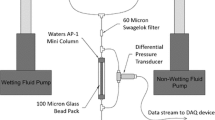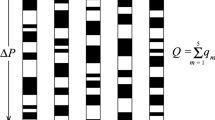Abstract
We investigate a two-dimensional network simulator that models the dynamics of two-phase immiscible bulk flow where film flow can be neglected. We present a method for simulating the detailed dynamical process where the two phases are allowed to break up into bubbles, and bubbles are allowed to merge together. The notions of drainage and imbibition are not adequate to describe this process since there is no clear front between the fluids. In fact, the simulator is constructed so that one can study the behaviour of the system far from inlets and outlets, where the two fluids have been mixed together so much that all initial fronts have broken up. The simulator gives the fractional flow as a function of the saturation of each of the fluids. For the case of two fluids with equal viscosity, we classify flow regimes that are parametrized by the capillary number.
Similar content being viewed by others
References
Aker, E., Måløy, K. J. and Hansen, A.: 1998a, Simulating temporal evolution of pressure in two-phase flow in porous media, Phys. Rev. E 58, 2217–2226.
Aker, E., Måløy, K. J., Hansen, A. and Batrouni, G. G.: 1998b, A two-dimensional network simulator for two-phase flow in porous media, Transport in Porous Media 32, 163–186.
Avraam, D. G. and Payatakes, A. C.: 1995a, Flow regimes and relative permeabilities during steady-state two-phase flow in porous media, J. Fluid Mech. 293, 207–236.
Avraam, D. G. and Payatakes, A. C.: 1995b, Generalized relative permeability coefficients during steady-state two-phase flow in porous media, and correlation with the flow mechanisms, Transport in Porous Media 20, 135–168.
Avraam, D. G. and Payatakes, A. C.: 1999, Flow mechanisms, relative permeabilities, and coupling effects in steady-state two-phase flow through porous media. The case of strong wettability, Ind. Eng. Chem. Res. 38, 778–786.
Batrouni, G. G. and Hansen, A.: 1998, Fracture in three-dimensional fuse networks, Phys.Rev.Lett. 80, 325–328.
Binning, P. and Celia, M. A.: 1998, Practical implementation of the fractional flow approach to multi-phase flow simulation, Adv. Water Resour. 22, 461–478 and references herein.
Blunt, M. and King, P.: 1990, Macroscopic parameters from simulations of pore scale flow, Phys. Rev. A 42, 4780–4787.
Buckley, S. E. and Leverett, M. C.: 1942, Mechanism of fluid displacements in sands, Trans. Am. Inst. Min. Eng. 146, 107–116.
Chen, J.-D. and Wilkinson, D.: 1985, Pore-scale viscous fingering in porous media, Phys.Rev.Lett. 55, 1892–1895.
Cieplak, M. and Robbins, M. O.: 1990, Influence of contact angle on quasistatic fluid invasion of porous media, Phys.Rev. B 41, 11508–11521.
Dullien, F. A. L.: 1992, Porous Media: Fluid Transport and Pore Structure, Academic Press, San Diego.
Haines, W. B.: 1930, Studies in the physical properties of soil, J. Agr. Sci. 20, 97–116.
Hansen, A., Roux, S., Aharony, A., Feder, J., Jøssang, T. and Hardy, H. H.: 1997, Real-space renormalization estimates for two-phase flow in porous media, Transport in Porous Media 29, 247–279.
Koplik, J. and Lasseter, T. J.: 1985, Two-phase flow in random network models of porous media, SPE J. 2, 89–100.
Lenormand, R., Touboul, E. and Zarcone, C.: 1988, Numerical models and experiments on immiscible displacements in porous media, J. Fluid Mech. 189, 165–187.
Lenormand, R. and Zarcone, C.: 1983, Mechanism of the displacement of one fluid by another in a network of capillary ducts, J. Fluid Mech. 135, 337–353.
Måløy, K. J., Feder, J. and Jøssang, T.: 1985, Viscous fingering fractals in porous media, Phys. Rev. Lett. 55, 2688–2691.
Måløy, K. J., Furuberg, L., Feder, J. and Jøssang, T.: 1992, Dynamics of slow drainage in porous media, Phys. Rev. Lett. 68, 2161–2164.
Paterson, L.: 1984, Diffusion-limited aggregation and two-fluid displacements in porous media, Phys. Rev. Lett. 52, 1621–1624.
Rothman, D. H.: 1990, Macroscopic laws for immiscible 2-phase flow in porous-media – results from numerical experiments, J. Geophys. Res. 95, 8663–8674.
Roux, S.: unpublished.
Washburn, E. W.: 1921, The dynamics of capillary flow, Phys. Rev. 17, 273–283.
Wilkinson, D. and Willemsen, J. F.: 1983, Invasion percolation: A new form of percolation theory, J. Phys. A 16, 3365–3376.
Witten, T. A. and L. M. Sander: 1981, Diffusion-limited aggregation, a kinetic critical phenomenon, Phys. Rev. Lett. 47, 1400–1403.
Author information
Authors and Affiliations
Rights and permissions
About this article
Cite this article
Knudsen, H.A., Aker, E. & Hansen, A. Bulk Flow Regimes and Fractional Flow in 2D Porous Media by Numerical Simulations. Transport in Porous Media 47, 99–121 (2002). https://doi.org/10.1023/A:1015039503551
Issue Date:
DOI: https://doi.org/10.1023/A:1015039503551




